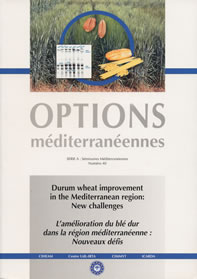| Article précédent | p. 373-379 | Article suivant |
Biotic stress limiting durum wheat production in Morocco - Hessian fly and the Russian wheat aphid: Surveys, loss assessment, and identification of sources of resistance
Hessian fly is the most destructive pest of wheat in the major cereal growing regions of the world. It is believed to have originated in West Asia which is the center of diversity of wheat, and has spread out to Europe, North Africa, and North America. Heavy populations are detected regularly in North America and western Mediterranean countries. In Morocco, grain yield losses have been estimated to 42 and 36 per cent in bread wheat using insecticide control, and near isogenic resistant and susceptible lines respectively. In durum wheat, losses have been estimated to 32 per cent. The most efficient and economic method of control of this pest is the genetic resistance via the use of resistant cultivars. In the USA, 29 genes of resistance have been characterized and named. Ten of these genes were selected as conferring resistance to Hessian fly in Morocco. The H22 gene has been successfully introgressed into adapted Moroccan bread wheat cultivars.
- [ Afficher ]
- [ Télécharger ]
- [ Exporter la citation ]
Vous pouvez télécharger la citation au format :
- [ Imprimer ]
-
Mots-clés
BLE DUR, MAROC, PERTE, PRODUCTION VEGETALE, STRESSCiter cet article
Lhaloui S., Nsarellah N., El Bouhssini M., Nachit M., Amri A. Biotic stress limiting durum wheat production in Morocco - Hessian fly and the Russian wheat aphid: Surveys, loss assessment, and identification of sources of resistance. In : Royo C. (ed.), Nachit M. (ed.), Di Fonzo N. (ed.), Araus J.L. (ed.). Durum wheat improvement in the Mediterranean region: New challenges . Zaragoza : CIHEAM, 2000. p. 373-379. (Options Méditerranéennes : Série A. Séminaires Méditerranéens; n. 40). Seminar on Durum Wheat Improvement in the Mediterranean Region: New Challenges, 2000/04/12-14, Zaragoza (Spain). http://om.ciheam.org/om/pdf/a40/00600061.pdf



